|

Gaining and using complete knowledge
of your services or plans

The buying motion consists of four menial steps-attention. interest,
evaluation and decision-through which the buyer's mind moves in order to arrive at a
favorable decision. The mind works much the same as the muscles of the body. When
information is fed to it in small, easy4o-handle steps, the mind can follow and understand
with little effort. The sales representative's skill in the use of motivation ideas
determines whether these steps will be easy or difficult for the buyer.

Now, think about the last time you walked up the steps of a large
municipal building. One thing you are sure to recall is the difficulty you had with those
long treads and the short risers. Trying to climb them can be compared to walking on
railroad ties. It's difficult, unnatural, and requires considerable effort. This is
because the steps were designed for beauty, not ease of climbing.
Architects and engineers studied the problem and found that the stairs
which were easiest to climb were those with steps that had a ten-inch tread and a
seven-inch riser. As a result, most modern-day steps are built this way.
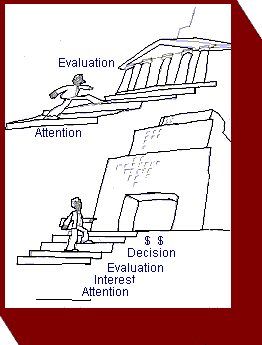
TOP
How is the sales representative's job similar to that of the architect?
Your job is to lead the prospect's mind Over the mental steps to acceptance or purchase.
Therefore, it is important for you to study and appreciate the prospect's viewpoint and to
present your ideas in easy-to-handle steps so that they can be understood.
Why is it difficult at times to make a logical presentation? Simply
because we tend to think our prospects have the same knowledge, experience and
understanding that we have. It seems only natural that they will have thought out their
future financial requirements and that they will have a clear conception of their needs.
It seems natural! too! that they will recognize the importance of our o.b.'s and
understand the g.q.'s that provide them. We assume! As a result, ideas which seem simple,
logical, and persuasive to us may be contradictory, confusing, and, therefore, meaningless
to prospects.
It's one thing to know and understand reason motivation ideas. But if
they are not employed at the right time and in the right way, the sales representative may
very well use a step which the prospect's mind cannot understand. Using the right
motivation ideas at the right time and in the correct way makes the sales presentation
logical.
Let's reconsider each of the motivation ideas discussed and this time
concentrate on how they are used.
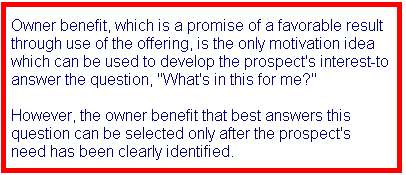
TOP
Once the prospect's interest has been stimulated, you must now offer
other reason motivation ideas for the evaluation process. These ideas must show that the
benefit described is possible and believable, and that in acquiring it, the prospect has
more to gain than has to be given up. But it is essential that the prospect's interest be
maintained throughout the presentation. Owner benefits then, are used in the evaluation
and decision phases of the buying motion as well as in the interest phase. From this it
can be seen that in the last two phases owner benefits are used in combination with other
motivation ideas.
When o.b. is used with g.q., it forms a powerful combination.

As simple as this may seem! using them improperly can create an illogical step for the
prospect's mind.
For example, let's suppose that you were talking with a prospect who was
considering additional insurance. You might say, "Your retirement years will he
worry-free (o.b.) because of the settlement option provisions (g.q.) of this plan."
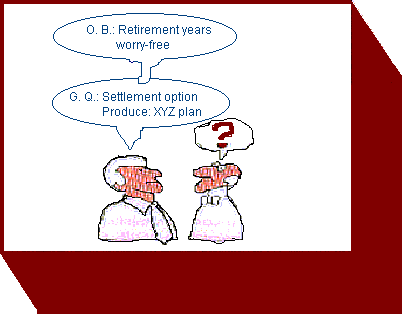
You understand sound selling principles. You're going about the
presentation the right way Apparently you've gotten attention and identified the prospects
need you're leading with an o.b and supporting it with a g.q. But does the g.q. clearly
and directly support the o.b.? It doesn't
In trying to support retirement years will be worry-free (o.b.) with
the settlement option provisions of this plan, (g.q.) you have put the prospect in the
position of having to relate the oh. and g.q. and the odds are he won't.
But suppose you had said, "You will receive a cheek for $1,500 per
month, (o.b.) making your retirement years worry-free (o.b.), Mr. Jones. The settlement
option provisions (g.q) of this plan provide for regular distribution of principal and
interest (o.b.) once each month beginning at age 65."
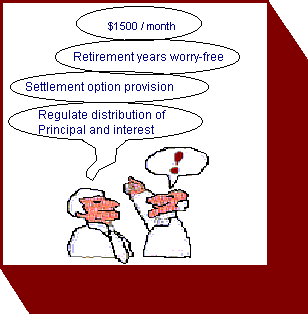
Isn't this statement more logical than the first attempt'? It is,
because the ideas have been presented in easier, more logical steps to help insure a
positive evaluation.
So, whenever you present an owner benefit that is not an immediately
apparent result of good quality, connect the two ideas with another oh. Or o.b.'s needed
to make the statement logical-believable. In other words, sell the result of the result.
As you have now seen, owner benefit is the only idea a sales
representative has to secure the prospect's interest. Having learned this, many sales
representatives are inclined to deluge the prospect with o.h.'s. Many times this occurs
after a hasty and incomplete effort to uncover the prospect's needs. Using too many o.b.'s
or unrelated o.b.'s can result in confusion, suspicion and loss of interest. Remember, in
using o.b.'s, your job 5 to lead the prospect's mind through the buying motion. Misuse of
o.b.'s can cause the opposite effect, resulting in loss of sales progress.
TOP
Building greater impact into sales presentations
Owner benefits and good qualities are important facts about your
products, services and plans that must be understood by prospects before they can buy
anything. Other facts, however, are equally necessary for prospects to know before they
can logically consider purchase.
The offering motivation idea
In addition to ob. and g.q., prospects must know four basic facts.
∑ Who
is making the offer (Company
and sales representatives)
∑ What
is being offered (product,
service or plan)
∑ Price or premium
∑ Terms
(method of payment and other
detals)
These four facts comprise the offering motivation idea- You might say
that the who and what are so basic that there is really no reason to discuss them. Yet in
a number of surveys, prospects agree that leaving this information out was a common
mistake made by sales representatives.
TOP
What's behind this complaint? Simply this. Prospects! like everyone
else, may have short memories and this could be a source of embarrassment td them in
interpersonal relationships. Suppose you've set up an appointment by phone. Between the
time of your initial phone call and visit, your prospect may just have forgotten what
Company you represent. Or he or she may have forgotten either your giving name or your
surname. In either case, your prospect may be too embarrassed to ask. This may be equally
true if you've had one or two previous meetings. In either case, it's not unlikely that
your prospect will focus more heavily on trying to recall your Company or your name than
on what you have to say.
If there is any question as to familiarity, therefore! you should
always mention your name and Company affiliation during the attention step of your
call or call back. You may also mention the first two parts of the offering
motivation
idea (who and what)
as you summarize your sales talk in the evaluation on step.
Now, let's look at the third and fourth parts (premium and terms) of
the offering motivation idea. As you know, any sale is an agreement between two parties,
just as a contract is an agreement between two parties. Such agreement cannot be reached
unless there is complete understanding by both parties of all elements of the offering.
The professional sales representative makes sure the prospeot understands all of these
elements. "Order takers" give out minimal information and hope to secure the
business. They avoid going into detail about premiums and terms since these may raise
objections.
However, if these are not discussed and accepted as worthwhile
obligations by prospects1 they may have second thoughts about the premium or
terms at a later date. It's not unusual to find, therefore, that it is the 'order
takers" who have the highest lapse rate in the district. There is no need for this.
The sales representative who has done a thorough job of identifyin9 needs and
expressing o.b.'s will be able to discuss premiums and terms without fear that
they' scare prospects off.
Since premiums and terms can be discussed safely only after prospects
understand the o.b.'s they will get, it should be evident that these two parts of the offering
motivation idea are brought up only in the evaluation step of the buying motion.
Now let's look at terms a little more closely. These include method of
payment, contingencies, assurances, and such details. Each of the details included in
terms may be considered a good quality of the plan being offered. As such, each will
provide many additional owner benefits for use in emphasizing the full importance of the
service or plan.
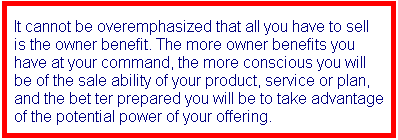
TOP
Summary-Gaining and using complete knowledge of
your services or plans
To ensure your prospect's understanding, reason motivation ideas must be employed
skillfully and logically.
A. Information should be presented in small, easy-to-handle steps.
B. Anytime the presentation becomes less than logical, the sales
representative has created a step which the buyer's mind may not be able to understand.
C. Do not assume that your prospect has the same knowledge, experience
and understanding that you have. Ideas which seem simple, logical and persuasive to you
may be contradictory, confusing, and therefore meaningless to your prospects.
II. Using the right motivation ideas at the right time and
in the
correct way makes the sales presentation logical.
A. Owner benefit-promise of favorable result through use of
offering-is only motivation idea that can be used to develop prospect's interest;
to answer question "What's in this for me?"
B. Owner benefit that best answers this question can be selected
only alter prospect's need has been clearly identified.
C. Once prospect's interest has been stimulated, other reason
motivation ideas must be offered for the evaluation process.
D. Owner benefits then, are used in evaluation and decision phases
of buying motion as well as interest phase.
E. The prime purpose of good quality in a sales presentation
is to support statements of owner benefits.
Summary-Building greater impact into sales presentations
I. Use of the offering motivation idea
A. The offering motivation idea is comprised of:
1. Who is making the offer
2. What is being offered
3. Price or premium
4. Terms
B.The professional sales representative makes certain that the prospect understands
all of these elements.
C. Premiums and terms should be discussed after your prospect understands the owner
benefits he will get from the offering. They should be brought up only in the evaluation
step of the buying motion.
TOP
|